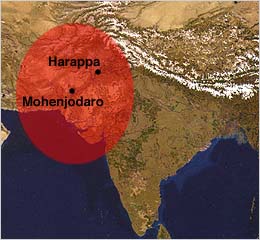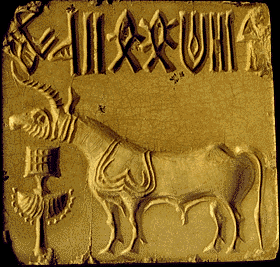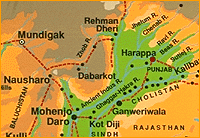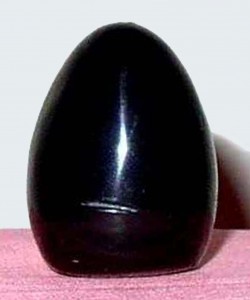Shiva-yoga, the secret name of which is Animisha-yoga, has been addressed as Prachina-yoga or the ancient Yoga in the Upanishads. Shiva-yoga has a very ancient history dating back to the chalcolithic age (Copper Age) which goes as far back as 5000 BC. The recent findings of Mohenjo Daro and Harappa have proved the existence of an advanced stage of civilization of a people that flourished in the Indus Valley. In the Proto-Indian period, the worship of Linga in the temples as also the worship of Linga worn on the body was in existence. The decipherment of the Mohenjo Daro inscriptions helps us to have a glimpse about the religion and philosophy of Proto-Indians or Dravidians. The self-existence of God is evident from the name of God Iruvan, the one who exists. Linga is the unifying principle of Shiva and Shakti, of Sat and Chit aspect of Reality. The concept of Linga as the union of positive and negative principles is conspicuous in the Shivagamas.
H.H. Shri Kumarswamiji has discussed these historical aspects of Shiva-yoga in the following article.
The recent findings of Mohenjo Daro and Harappa have proved the existence of an advanced stage of civilization of a people that flourished in the Indus Valley. They exhibit that the Indus people who belong to the chalcolithic age(Copper Age) which goes as far back as 5000 BC are in possession of a higly developed culture in which no vestige of Indo-Aryan influence is to be found. Sir John Marshall in his “Mohenjo Daro Indus Civilization” devotes one full chapter to the religion of the Indus people. Therein he concludes that those people worshipped Mother Goddess, Shakti, and a male deity Shiva. He identified the male deity with Shiva because of the prominent characteristics of the deity having three eyes and being a Mahayogin as represented on seals, images, carvings and other signs discovered in different sites. Thus remarks Sir John Marshall:
“In the religion of the Indus people there is much of course that might be paralleled in other countries. This is true of every prehistoric and of most historic religions as well. But taken as a whole, their religion is so characteristically Indian as hardly to be distinguishable from the still living Hinduism or at least from that aspect of it which is bound up with the animism and the cults of Shiva and Mother Goddess – still the two most potent forces in popular worship.”
From left to right – Map of India (pre-independence), Seal obtained in Harappa excavation, Seal obtained in Harappa excavation, Mohenjo Daro and Harappa sites
Image Courtsey — http://www.harappa.com
The term Minakanna, obtained in the same inscriptions, suggests the early idea of yogic discipline. In those remote days, the yogis noted for their asceticism and discipline were addressed as Minas. That life of asceticism was practised in the Proto-Indian period is evident from the fact that one of the inscriptions mentions, “the learned Minas who dwell in the caves”. Cave dwelling was not ordinary in those days when beautifully built brick houses were common. The learned Minas dwelling in the caves could not be but ascetics. Shiva-yoga was sponsored by these learned Minas dwelling in the caves. “One marble statue has the head, neck and body quite erect and half shut eyes fixed on the tip of the nose. Another is draped in the upavita fashion passing over the left shoulder and under his right arm. His shawl has rosettes having a form of the Bilva leaf, the most sacred material for worship in the Shiva cult. The philosophy of the age crystallized in the discipline known later as Brahmacharya. Sexual restraint is in evidence in the urdhvamedra representation of Shiva on the seal. It is not phallic orgies but their conquest that constituted the essence of yoga at that time.” Shiva-yoga has a historical background though we are unable to formulate all the details of Shiva-yoga prevailing at that period. In course of time, the practice of Shiva-yoga and even the shape of Linga seem to have undergone changes. Shiva-yoga is democratic in the sense that everybody is eligible to practise it, irrespective of caste, colour, creed, rank, age, sex and position. It is scientific in the sense that it is entirely based upon the laws of light and electricity.
Shiva is addressed as Lingodhbhavamurti, the self-existent Truth. The image of Shiva, called Shivalinga, found in all the Shaivite temples is only a plastic representation of this self-existent Truth. In the Proto-Indian period, the worship of Linga in the temples as also the worship of Linga worn on the body was in existence. As time rolled on, a distinction arose in the mode of worship. The worshippers of Linga worn on the body were known as Virashaivas. The Linga worshipped in the temples goes by the name of Shivalinga or Sthvaralinga and the Linga worshipped and worn on the body goes by the name Ishtalinga. “The only explanation applicable to them (the Lingas found in the Indus Valley) is that they were sacred objects of some sort, larger ones serving as anconic amalgamate, the smaller as amulets to be carried on the person, just as miniature Lingas are commonly carried by Shaivites today.” Ishtalinga is a miniature of Shivalinga; it is worshipped by placing it on the palm of the left hand so raised as to bring it in line with the centre of the eyebrows. Ishtalinga is made of light, grey slate-stone and to be kept intact it is coated all over with a fine durable paste prepared out of certain ingredients. The colour of the paste is blue-black or indigo; the colour of Ajna chakra, situated in the centre of the eyebrows, is also indigo. The colour of the covering of Ishtalinga and that of Ajna chakra, being akin in nature, they act and react upon each other thus enriching the magnetic force or intuitive power.
Sthavar-linga worshipped by Shaivas Ishta-linga worshipped by Veerashaivas
The term Minakanna is pregnant with meaning. In after days, it was translated into Sanskrit as Animishadristi or unblinking gaze. Crystal gazing is as old as the hills and the belief that it generates magnetism is also equally old. It was only in 1850 that John Reichenback discovered this magnetism and described it as odylic force. He announced that odylic force could be generated by crystal gazing and by crystal magnets on the human body and human hands. His experiments were conducted in the natural waking condition of a subject. Since then odylic force has been photographed and there are reasons to believe that magnetic crystals and human bodies send forth emanations which can be felt and sometimes seen by sensitive persons. Ishtalinga which is an indispensable means of Shiva-yoga is a stone with a glazing covering; since the steadfast gaze on Ishtalinga generates magnetism, Ishtalinga is a crystal magnet.
Crystal gazing enables one to observe the emanations extending from the etheric body and to determine the state of a person’s health by the colour and intensity of the aura. The etheric body sends out longer and shorter or positive and negative vibrations and this is why the appearance of those vibrations outside the physical body is known as the etheric double. The aura depends upon the etheric power which the etheric body sends out, permitting greater ease in the transmission of those rays where the vibrations tend to neutralize, the negative long vibrations tend to curve in and contact the positive vibrations causing short circuiting which makes the aura dull and spotted. The etheric body is the connecting link between the physical body and the ego, when the main positive-negative vibration at the glabella, that is, at the centre between the eyebrows is neutralized, the silver cord connecting the body and the ego is said to have broken loose. The steadfast gaze on the speck of light reflected in the coating of Linga placed at the palm of the left hand so raised to come in line with the centre of the eyebrows, keeps the silver cord intact making the body disease free and ego care-free.
This article ‘Historical Aspects of Shiva-yoga’ is taken from H.H.Mahatapasvi Shri Kumarswamiji’s book,’Technique of Opening the Third Eye’.







